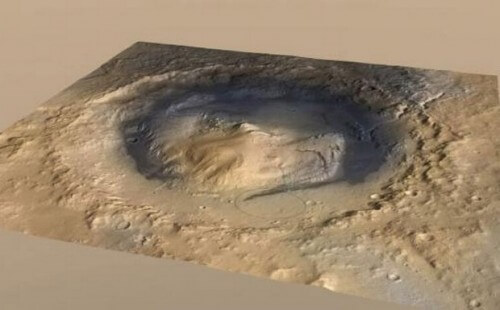This is what Professor Omri Vandel from the Rakah Institute of Physics at the Hebrew University says in response to the discovery published by NASA about a week ago

The Curiosity spacecraft that landed over two years ago (August 2012) in Gale Crater on Mars is actually at the bottom of an ancient lake. The fact that the crater, which is 154 km in diameter, is a lake, indicates that in the past Mars was more similar to Earth and was suitable for colonization by bacteria.
.
The scientists discovered piles of rocks containing deposits of water-derived sediments inclined towards the center of the crater, which now has a 5 km high mountain known as Mount Sharp. This means that Mount Sharp did not exist during the period 3.5 billion years ago when the crater was filled with water.
"Discovering the tendency was a complete surprise to us," says lead scientist John Grotzinger of Caltech in Pasadena. "Sedimentary geology is the most innovative means of understanding the Earth. When oil companies conduct seismic surveys in certain islands, they look for this inclined layer because the geometry tells us where the rocks we are looking for are located," he added.
Not long after landing, Curiosity discovered that Mars once contained the chemical components and environmental conditions required to support microbial life, thus fulfilling the mission's primary purpose. Now the vehicle is making its way towards Mount Sharp.
Professor Omri Vandel from the Rakach Institute of Physics: "This in itself is not sensational new, since geological signs of water on Mars were already found in previous missions such as the Spirit and Ophotonity in 2005, but the Curiosity findings show sedimentary rocks in inclined layers, which indicates that they were formed over a long period of time, like geological ages On Earth, contrary to the opinion that has prevailed so far, that Mars was warm enough to sustain liquid water on the surface only for a relatively short period of time."
"The importance of this is great regarding the possibility of the development of life in the ancient lakes that were on Mars. Even if today no evidence of such life has been found on the surface, the existence of suitable conditions for the development of life on Mars over a long period of time in the past has something to teach about the beginning of life on Earth.

5 תגובות
Who wants pictures of Mars with buildings and cities in the centers of craters and around them?
And that NASAS will decide... either their photos are fabricated or they are indeed real from Mars.
You will find the original TIFF photographs of Hale Crater and many others.
Download the red spectrum, increase several times without any filters and regrets.
And you won't believe it... buildings, pyramids, geometric caves, huge sculptures. It is possible to verify against several different photographs of the same area.. Everything is concentrated in specific areas, so that you will not be impressed that it is a JPG distortion... because it is a TIF, and it is from several photographs. No amount of probabilistic error can undo that.
If you are really interested in researching the issue, then try and don't be parrots... first check it, then we will see you denying stupidity...
It is possible that the hot climate was created together with the red Mount Olympus. After the volcanic activity stopped. The "atmosphere" sank and Mars took on a red color. To my theory, I add the fact that Mars contained liquid water, only for hundreds or thousands of years.